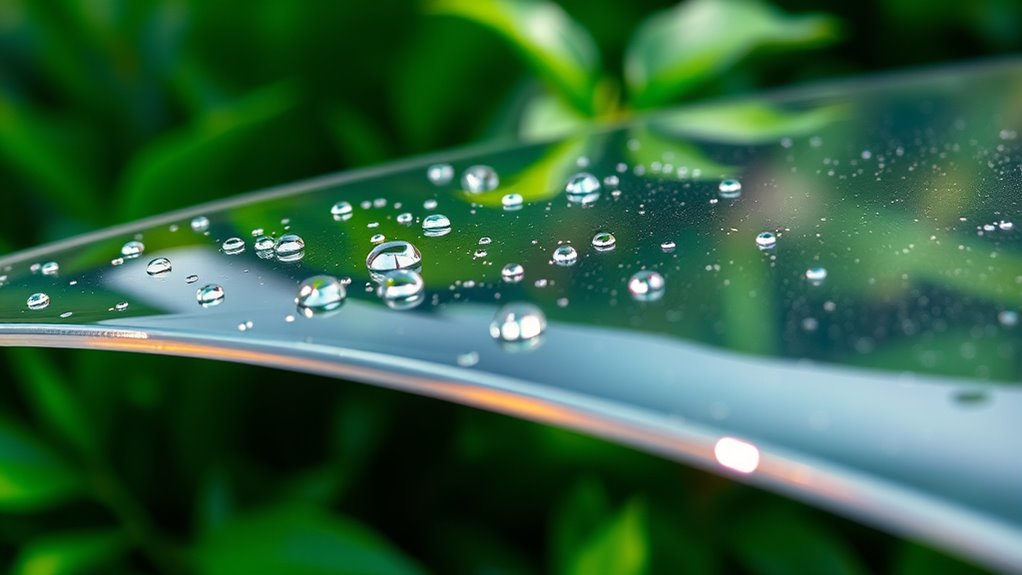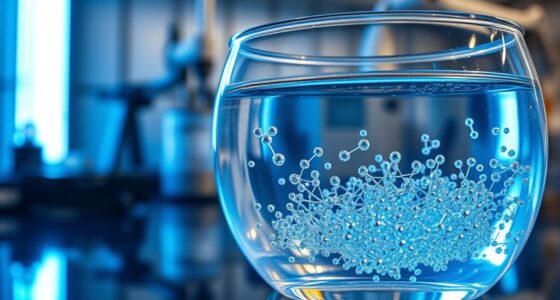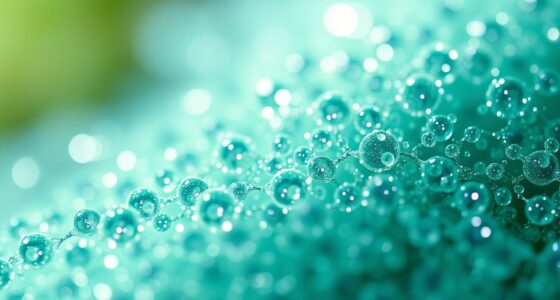Eco-friendly nanocoatings help you protect surfaces sustainably by using biodegradable materials from renewable sources and eco-conscious manufacturing processes. They offer durable, long-lasting coverage that reduces waste and minimizes environmental impact. These coatings are easy to apply without harmful chemicals, supporting a healthier planet while maintaining effectiveness. Supported by transparent supply chains through advanced technologies, they ensure responsible sourcing. Keep exploring to discover how these innovative coatings can make your environmental choices even smarter.
Key Takeaways
- Eco-friendly nanocoatings are made from biodegradable, bio-based materials derived from renewable sources, reducing environmental impact.
- They offer durable, long-lasting protection against water, dirt, and UV rays, minimizing the need for frequent reapplications and waste.
- Manufactured through sustainable processes that generate minimal waste and energy use, supporting eco-conscious production.
- Designed for easy, transparent application without toxic solvents, encouraging widespread adoption of sustainable surface protection.
- Supported by blockchain technology ensuring transparent, responsible supply chains from raw materials to finished products.

Are eco-friendly nanocoatings the future of sustainable protection? As someone invested in reducing environmental impact, you’ll find that these advanced coatings are transforming how we think about surface protection. Unlike traditional options that often rely on harsh chemicals, eco-friendly nanocoatings are developed through sustainable manufacturing processes, guaranteeing minimal waste and energy consumption during production. This approach aligns with your goal to support environmentally responsible choices, making nanocoatings a compelling option for eco-conscious consumers and industries alike.
One of the key advantages of eco-friendly nanocoatings lies in their use of biodegradable materials. These coatings break down naturally over time, returning to the environment without leaving harmful residues. This biodegradability means you can protect surfaces—whether on your home, vehicle, or electronics—without contributing to long-term pollution. As you explore sustainable solutions, you’ll appreciate that biodegradable nanocoatings reduce landfill waste and lessen the burden on ecosystems, aligning with your desire to promote a healthier planet.
The manufacturing process of these nanocoatings emphasizes sustainability. Instead of relying on toxic chemicals or non-renewable resources, manufacturers often utilize bio-based ingredients derived from renewable sources. This shift ensures that producing nanocoatings doesn’t deplete natural resources or generate excessive emissions. When you choose products made through sustainable manufacturing, you’re supporting a cycle that minimizes environmental footprint from start to finish.
Furthermore, these nanocoatings offer durable, long-lasting protection without sacrificing eco-friendliness. Their nanoscale structure provides excellent resistance to water, dirt, and UV rays, which means fewer reapplications and less waste over time. You won’t need to replace or recoat surfaces as frequently, reducing material consumption and waste generation. This durability, combined with their biodegradability, makes them a practical choice for those committed to sustainable living.
In addition, many eco-friendly nanocoatings are designed with transparency and ease of application in mind. You can effortlessly coat a variety of surfaces without the need for complex procedures or toxic solvents. This user-friendly aspect encourages more widespread adoption, helping you integrate sustainable practices into everyday life effortlessly. As you consider environmentally responsible options, these nanocoatings stand out because they don’t compromise on performance while prioritizing the health of the planet.
Furthermore, advances in tokenization and blockchain technology are supporting the development of transparent supply chains for eco-friendly materials, ensuring that these nanocoatings are truly sustainable from production to application.
Frequently Asked Questions
Are Eco-Friendly Nanocoatings Safe for Human Health?
Eco-friendly nanocoatings are generally safe for human health when they meet regulatory standards, but concerns about nanoparticle toxicity still exist. You should guarantee products are tested thoroughly, as poorly regulated nanocoatings might pose risks. Follow safety guidelines, and choose coatings from reputable sources. While they’re designed to be safer, ongoing research continues to evaluate long-term effects, so stay informed about the latest safety updates.
How Long Do Eco-Friendly Nanocoatings Typically Last?
Eco-friendly nanocoatings typically last between 2 to 10 years, depending on their durability lifespan and exposure conditions. You’ll find that their degradation rate influences how long they remain effective; environmental factors like sunlight, moisture, and abrasion can accelerate breakdown. To maximize longevity, choose coatings designed for your specific application, and follow proper maintenance routines. Regular inspections can help guarantee you get the most out of your eco-friendly nanocoating over time.
Can Eco-Friendly Nanocoatings Be Applied to All Surfaces?
Imagine a sleek, glassy surface shimmering under sunlight—that’s the kind of finish eco-friendly nanocoatings can create. While they work wonders on many surfaces, surface compatibility and application limitations exist. You might find they adhere best to smooth, non-porous materials like glass, metal, or certain plastics. However, rough, porous, or uneven surfaces could pose challenges, so it’s wise to check compatibility before application to guarantee the best results.
What Is the Cost Difference Compared to Traditional Coatings?
You’ll find that eco-friendly nanocoatings generally have a higher price difference compared to traditional coatings. The cost comparison shows they can be 10-30% more expensive upfront due to advanced materials and manufacturing processes. However, you might save money over time because these coatings often last longer and reduce maintenance costs. While initial investments are higher, the long-term benefits make eco-friendly nanocoatings a cost-effective choice for sustainable surface protection.
How Do Eco-Friendly Nanocoatings Impact Environmental Degradation?
You might not realize it, but eco-friendly nanocoatings considerably reduce environmental degradation by lowering your ecological footprint. They often address biodegradability concerns, breaking down more naturally and quickly than traditional options. Studies show these coatings can decrease pollutant runoff by up to 40%. By choosing them, you help minimize harmful chemicals entering ecosystems, preserving biodiversity and health for future generations. Your actions directly support a healthier planet and sustainable development.
Conclusion
As you embrace eco-friendly nanocoatings, you gently nurture a more sustainable future, where innovation and nature subtly intertwine. By choosing these advanced solutions, you’re quietly guiding the world toward harmony, leaving behind less of a footprint. Though the path may seem delicate, your mindful decisions ripple outward, fostering a subtle shift that benefits both the environment and your conscience. In this quiet revolution, your small acts help paint a brighter, greener horizon for generations to come.









